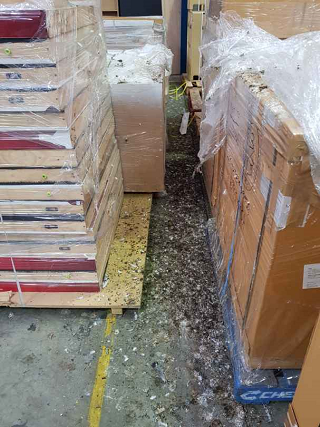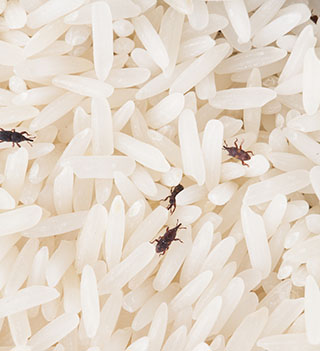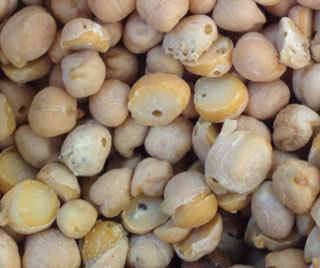Pest - the word brings cockroaches, ants or bed bugs to mind. But there are dozens of species of insects and other critters that live and breed in stored foodstuffs. They can cause diseases and allergies by spoilage of food, not to mention the disgust of you eating them accidentally. This blog describes the main types, and how the right food pest control can keep them down.
Economic Costs of Food Pests
 Over 20% of the world's grain production is lost to pests each year. They affect each stage after harvest - storage, transport and distribution, not to mention invading homes.
Over 20% of the world's grain production is lost to pests each year. They affect each stage after harvest - storage, transport and distribution, not to mention invading homes.
Warehouses are particularly vulnerable to insects like weevils and ants, since they give not only an endless supply of food, but also shelter from predators. Larger pests like birds and rodents can also harbour insects in their nests and burrows.
In processing plants, these pests can not only damage machinery but also invite significant fines from food inspectors.
At home, unpackaged food like grain, flour, fruits and vegetables, may be infested with eggs or larvae when you buy it. They are nearly impossible to see without a magnifying lens, and often well camouflaged. You may not notice them until weeks later, when pest faeces and moults cause discolouration of food or a change in its flavour and texture.
Chief Food Industry Pests
Apart from invasive species like ants, there is a category of Stored Product Insects (SPIs) which live and breed within food:
-
Coleoptera
With over 400,000 species, this category of insects includes beetles and weevils. Mostly agricultural pests, some also infest food like flour, seeds, and fruits. They often bore into the food and lay eggs within them. Some can fly from place to place, while others spend their whole lives within your jar of flour.
-
Lepidoptera
This includes 180,000 species of butterflies and moths, of which only 30 species are pests. Adults fly from place to place laying eggs- but it's their caterpillars that are significant. They damage greens, fruits and even natural fabrics like cotton and wool. Some can even chew product packaging.
-
Acari
A class of arachnids, this includes mites and ticks. Mites are a significant food pest worldwide, mainly because they are rarely larger than 1 mm across. They are found in every habitat: soil, plant litter, dust, bark, furniture, clothing, ant and bird nests and rodent burrows.
They are parasites of plants, birds, mammals and insects, living on dead skin cells. They infest dry foods like flour, grain, seeds, nuts, cheese and preserved meats. Being microscopic, they can be breathed in causing severe allergies, and also skin irritations (grocer's itch).
Foods Vulnerable to Infestation

Although unprocessed, unpackaged food are vulnerable, insect pests (especially weevils) can also nest in packaged and processed food products, immune to preservatives. So be mindful when buying pastas, packaged cereals, nuts, cheeses and meat products.
Some insect pests can also nest in other natural products like wool, cotton and leather.As some of these pests are invasive, they can attract costly quarantine penalties.
-
General Feeders
These insect pest species can thrive on practically anything in your store, from chocolate to spices, and even cigarette tobacco! Cereals, flour, nuts, seeds and beans are also prone to attack.
The common insects are the tobacco moth (Ephestia elutella), cigarette beetle (Lasioderma serricorne), grain beetles (Oryzaephilus surinamensis and O. mercator), and the drugstore beetle (Stegobium paniceum). But it is more common for pests to specialise.
-
Whole Grain
They infest stored whole grains like wheat and barley, even though the grains have tough outer skins. The insects are usually the size and colour of the grains, so they are easily camouflaged. The Khapra (Trogoderma granarium) in particular is invasive to Australia, and grain imports must undergo strict quarantine procedures. Others include the grain moth (Sitotroga cerealella), rice weevil (Sitophilus oryzaei), granary weevil (Sitophilus granaries), cadelle (Tenebroides mauritanicus) and Australian wheat weevil (Rhyzopertha dominica).
-
Broken Grain and Flour
These are vulnerable to a wider range of insects and mites. These also infest dried foods and flour products like pasta. Our food industry pest control experts have identified the following as major insect invaders:
- spider beetles: white-marked (Ptinus fur), Australian (Ptinus ocellus)
- grain beetles: Siamese (Lophocateres pusillus), flat (Cryptolestes pusillus) rusty (Cryptolestes ferrugineus)
- flour beetles: confused (Tribolium confusum), rust-red (Tribolium castaneum)
- broad-nosed grain weevil (Caulophilus oryzae)
- Mediterranean flour moth (Ephestia kuehniella)
- Indian meal moth (Plodia interpunctella)
- yellow mealworm (Tenebrio molitor)
Infestation by grain or flour mite (Acarus siro) can impose severe financial losses. Glycyphagus domesticus is another mite that will infest grain, sugar, flour, cheese, tobacco and even hay.
-
Meat and Cheese
These high-protein foods are attacked by carrion feeding insects, mostly coleopterans of the genus Dermestes: larder beetle (D. lardarius), black larder beetle (D. ater) and hide beetle (D. maculatus). Cheese is prone to attack by the cheese mite (Tyrophagus casei), which also attacks stored grain and flour. Related pests include Anthrenus, Trogoderma, Attagenus species, and also the red-legged ham beetle (Necrobia rufipes).
As they also eat dead birds, rodents and other pests, these insects are also seen in grain warehouses and food processing property. They often breed in nests, carpets and leather, and some larvae bore into wood to pupate. In nature though, these insects serve the useful purpose of scavenging on dead animal matter.
-
Dried Fruit and Nuts
Rich in sugar, many of these are quite insect- and germ-resistant. But with passage of time or poor storage, they become vulnerable to mould, which breaks doen the sugars and attracts insects like almond moth (Cadra cautella), dried fruit moth (Vitula edmandsae serratilineella), stored nut moth (Aphomia gularis), dried fruit beetle (Carpophilus hemipterus). The dried-fruit mite (Carpoglyphus iactis) prefers raisins, figs, sultanas, dates, and fermented foods. Mouldy food products invite the mould mite (Tyrophagus putrescentiae) especially those rich in fats, like seeds, nuts and ham. Apart from these, general feeders and meal moths can also infest and nest in stored fruits and nuts.
-
Legumes
Among the main insect infesters of beans and peas are weevils of family Bruchidae, especially Acanthoscelides obtectus.
Detecting and Destroying Stored Product Insects

Pest control in food industry is carried out by trained and certified technicians, but it begins with you.
Regular inspections and 'sweeps' of your food storage and processing property, especially when new batches are delivered or being despatched, will ensure your neither import nor export an infestation.
Make sure that the suppliers and transporters you work with have processes in place for pest inspection and control.
Here are a few things you should check during a sweep:
- Holes drilled into stored grains, seeds and nuts indicate coleopterans. Also holes made by larvae in food cartons and plastic.
- Insect remains like eggs, pupal cases, wings, moults, or webs; live adults and larvae in machinery, store shelves and packaging material.
- Insects in spillages may indicate damaged or leaking product packaging.
- Ant-nests and colonies in shelving, home and store furniture, window-sills, roofing beams, as well as in wall and floor cracks.
- Insects caught in traps, fly paper or electric fly killer.
Conclusion
Following pest control protocols laid out for the food industry according to Australian federal, Victoria state and Melbourne city guidelines will make sure that your warehouses, retail property, stores and plants in and around Melbourne will remain safe and compliant.
A professional pest control management contract will ensure that you have the expertise, advice and round the clock services of trained insect controllers like Protech Pest Control.